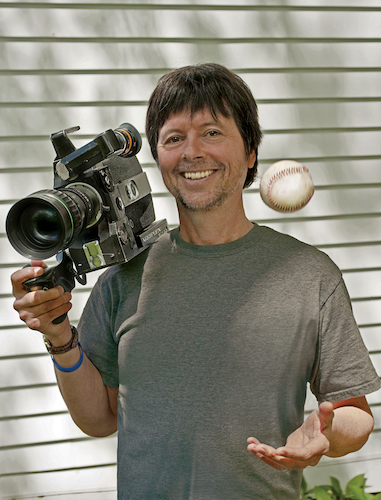Communiqué
BASEBALL Continues with “The 10th Inning” – May 27 at 9 pm
< < Back toQ&A WITH KEN BURNS AND LYNN NOVICK,
DIRECTORS OF THE TENTH INNING
Thousands of bats, three home run records and one “curse” have been broken since Ken Burns last explored the history of America’s national pastime with his landmark 1994 PBS series BASEBALL. Burns and co-director Lynn Novick updated the series in 2010 with THE TENTH INNING. Beginning with a crippling strike that alienated millions of fans and brought the game to the brink, this film tells the tumultuous story of our national pastime up to the present. It celebrates baseball’s new Golden Age — an era of unprecedented home run totals, popularity and prosperity — and sheds light on one of the game’s darkest chapters — the steroid era. The two-part, four-hour film, airing Thursdays, May 27 and June 3, 2021, 9:00-11:00 p.m. on WOUB, examines the compelling stories of Joe Torre, Mark McGwire, Sammy Sosa, Pedro Martinez, Ichiro Suzuki, Cal Ripken Jr. and Barry Bonds and features insightful commentary from an eclectic lineup of writers, broadcasters, fans and all-stars.
The film’s directors Ken Burns and Lynn Novick answered questions about the film taken from fans on the PBS Facebook page .
Are there great new stories and new faces in THE TENTH INNING? How did you manage without Buck O’Neil?
LYNN NOVICK: Tragically, we were not able to interview Buck O’Neil before he passed away, but he was with us in spirit throughout the entire project and the film is dedicated to him. While we did reconnect with many other old friends from our original series, we are also able to include some fascinating new voices who enriched the film immeasurably.
In addition to Bob Costas, Thomas Boswell, George Will, Daniel Okrent, Roger Angell, Gerald Early, John Thorn and Doris Kearns Goodwin, we interviewed broadcasters Keith Olbermann and Jon Miller; writers Howard Bryant, Marcos Breton, Steve Wilstein, Mike Barnicle and Tom Verducci; and comedian Chris Rock. They all enriched the film with terrific anecdotes and profound insights about the game.
Several iconic figures from the recent era also agreed to be interviewed and their stories are as compelling as any in the first nine innings. Joe Torre shared his memories of coming to New York to work for the game’s most irascible and demanding owner, George Steinbrenner, and leading the team to the World Series in his first season. Pedro Martinez talked about growing up in the Dominican Republic, coming to America, the art of pitching and, of course, playing for the Red Sox in the momentous 2003 and 2004 seasons. Ichiro Suzuki shared his unique perspective on the game both in Japan and America, and Felipe Alou reminisced about managing the upstart Montreal Expos in 1994 and the devastating impact of that season’s disastrous strike.
How did the strike and steroid era affect your personal relationship to the game? Did you lose faith during those years?

KEN BURNS: At first, it shook my confidence, but then it propelled us to this update. And by studying the steroids era, we have come to terms with it, feel we have understood it and hope we have communicated that understanding to our viewers.
NOVICK: The strike was hugely disappointing — a real shock to the system. Just at the moment when we were trying to celebrate the game with the broadcast of our series, the players and the owners let us all down. All summer long in 1994, as negotiations went nowhere, we could see disaster looming, and when it finally happened, it was tough to try to remember the things we loved about baseball. But I remember being relieved that it had all gotten settled, and more than anything being curious to see how the players and owners were going to set about rebuilding that connection with the public.
When home runs began soaring out of the park at an unprecedented rate in the late 1990s, I felt that baseball was being somehow cheapened, made into a spectacle that took away from the game’s enduring charm and timelessness. I assumed that the huge sluggers must be taking something, but didn’t fully appreciate how steroids were changing the game from within until later. It wasn’t a big surprise, knowing that professional athletes in every sport always face these temptations and always look for an edge.
In the end, strangely, the steroids scandal has had the unintended consequence of forcing us as fans to recognize that the players are actually human beings — much as we want to worship them as heroes, gods, immortals. And in the end, the revelations about performance-enhancing drugs, paradoxically, have brought them closer to us. We all make mistakes, we all face temptations and though we like to think we would do the right thing, hopefully we have learned not to be too quick to judge. So, yes, the steroids scandal has cast a long shadow on some of the era’s greatest stars and their outsized accomplishments, and forced us to ask questions that probably will never be fully answered. But, for me, anyway, it has also has added depth and nuance to my love for the game in all of its complexity.
Who is your favorite player of all time? Which player do you respect the most?
BURNS: Willie Mays and Jackie Robinson
NOVICK: Of course, Jackie Robinson is the one player who towers above everyone else in the game — for his courage in breaking the color line and for his ability to play the game at such an extraordinarily high level while facing pressures and prejudices that are beyond imagining. America is extremely fortunate that he agreed to be the first African-American player in “organized” baseball — who else could have borne that burden so magnificently?

Did you try to balance Red Sox and Yankees, to keep the Red Sox bias in check?
BURNS: The Red Sox got me thinking. The steroids scandal got us to act. And the Yankees get their due.
NOVICK: Having made the Boston Red Sox one of the central through lines in the original series, when they miraculously beat the Yankees and then won the World Series in 2004, we desperately wanted to update the series — to do a sequel for the first time in our careers. Of course, we wanted the saga of the Red Sox to be a big part of THE TENTH INNING, but there was no danger of too much Red Sox bias in the film because while Ken, our editor Craig Mellish and David McMahon (who produced and wrote the film with us) are die-hard Boston fans, their passions were counterbalanced by me and our associate producer Mike Welt, both of us equally passionate about the Yankees. Our divided loyalties kept us from taking ourselves too seriously and made for a lot of good-natured ribbing in the editing room.
Will THE TENTH INNING include teams besides the Red Sox and Yankees?
NOVICK: You bet. We have extensive scenes about players and teams far beyond the northeast. Among them: the Atlanta Braves, the San Francisco Giants, the Oakland Athletics, the California Angels, the Seattle Mariners, the St. Louis Cardinals and the Chicago Cubs.
 What will be done to maintain the integrity of pre-steroid-era records?
What will be done to maintain the integrity of pre-steroid-era records?
NOVICK: Rather than thinking of the record book as some kind of sacrosanct accounting of baseball’s halcyon days, we have to recognize that they actually reflect the game and all of its imperfections across the years. The greatest scandal in the history of baseball is not the steroid era, but the fact that gamblers had significant influence over the game in the early 20th century — culminating in the World Series of 1919 being thrown by the Chicago White Sox. At that point, many Americans did not believe the game was “on the up and up” and had no faith in the integrity of the sport as a whole. Yet, in the record book, the Cincinnati Reds, who were handed the championship by the far superior White Sox, are simply listed as the winners of the series. Perhaps they should have some kind of asterisk next to their win — but they don’t. What this tells us is that the responsibility lies with all of us to look beyond the numbers to tell the stories behind the records, to put flesh on the bones of all of those endless statistics. For instance, how are we to account for the fact that Babe Ruth broke records without ever having to face some of the greatest players in the game — who were barred because of the color of their skin? As Chris Rock once put it, “Babe Ruth has 714 affirmative action home runs.” What are we to make of the fact that the pitching mound was lowered after 1968 to bring more offense to the game? Will Bob Gibson’s extraordinary 1968 ERA of 1.12 ever be broken? In other words, the statistics are an expression of a complicated baseball past that is much more interesting than the idealized one we so want to hold on to.


